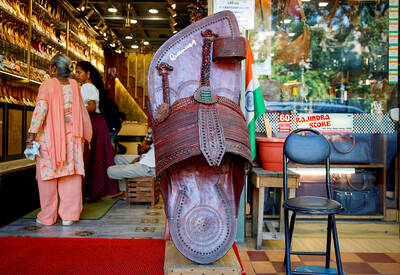VIA Technologies Inc (威盛電子) will benefit from S3 Graphics' popular graphics chips for notebook computers by increasing its ability to expand into the notebook market, an official at VIA said yesterday.
The official made the comments after S3 Graphics announced on Monday that Hewlett-Packard had become its latest customer to use S3 Graphics' graphics chips for HP's latest notebooks.
"S3 Graphics will be controlled by VIA in the next year," said an official at VIA. "Because the graphics technology developed by S3 in the notebook market is very famous, we can use this technology to expand our [notebook] market share," he said.
S3 Graphics, a division of S3 Inc, announced on Monday that Hewlett-Packard would use its Savage/IX graphics chip in two new notebook computer models HP has started selling recently. HP joins S3 Graphics' client list of other major notebook manufacturers, including IBM, Toshiba, NEC, and Micron Electronics, that are using the Savage/IX chip.
S3 Graphics specializes in discrete and integrated graphics for the mobile and desktop market. VIA is the world's second largest computer chipset designer.
At the end of August, S3 Inc announced it had restructured an agreement to sell S3 Graphics to a new joint venture with VIA in order to meet concerns raised by the Taiwan government.
Securities analysts contacted yesterday were uncertain about the current status of the agreement, but the VIA official said that VIA and S3 had signed the agreement and the government had now approved the joint-venture. "The whole case will be completed early next year," the official said.
Through the new venture, VIA will combine the graphics technology of S3 Graphics with its own chipset technology. At the end of September, the future partners jointly announced the availability of integrated graphics chipsets supporting AMD and Intel processors.
As well as developing its systems on a chip technology, VIA will also benefit from S3 Graphic's technology and client-base to expand into the notebook market. "Through the Savage/IX graphics chip, VIA can get more customers in the notebook market," the VIA official said. "VIA was not strong enough in the market before; se we can get fast growth in this market through graphics integrated products."
The Savage/IX graphics chip has been popular with notebook makers because of its embedded design that consumes less power than other products and supports up to 16MB of memory, the most currently available.
VIA's goal is to take a 50 percent stake in the world's graphics chip market for notebook computers. However, S3 Graphics is likely to make only a limited contribution toward reaching that goal, analysts said. "VIA wants to increase its position in the notebook market," said an analyst at Sampo Securities.
However, the effect of the graphics chip won't be so big as the product requirements for notebooks are far stricter than for desktop PCs, he said. "This kind of product system is difficult to break into," he said.
Even if the cooperation with S3 Graphic is helpful for VIA to enter the notebook market, any benefits would take time to materialize, analysts said. "It could help indirectly," said an analyst at Taiwan International Securities Corp, "but the effect won't be felt quickly," she said.
Furthermore, the notebook market is small in comparison with the desktop PC market, analysts said. So even if VIA does enter the market in the near term, its revenue will still be decided by desktop PC sales, analysts said.

MARKET LEADERSHIP: Investors are flocking to Nvidia, drawn by the company’s long-term fundamntals, dominant position in the AI sector, and pricing and margin power Two years after Nvidia Corp made history by becoming the first chipmaker to achieve a US$1 trillion market capitalization, an even more remarkable milestone is within its grasp: becoming the first company to reach US$4 trillion. After the emergence of China’s DeepSeek (深度求索) sent the stock plunging earlier this year and stoked concerns that outlays on artificial intelligence (AI) infrastructure were set to slow, Nvidia shares have rallied back to a record. The company’s biggest customers remain full steam ahead on spending, much of which is flowing to its computing systems. Microsoft Corp, Meta Platforms Inc, Amazon.com Inc and Alphabet Inc are

Luxury fashion powerhouse Prada SpA has acknowledged the ancient Indian roots of its new sandal design after the debut of the open-toe footwear sparked a furor among Indian artisans and politicians thousands of miles from the catwalk in Italy. Images from Prada’s fashion show in Milan last weekend showed models wearing leather sandals with a braided design that resembled handmade Kolhapuri slippers with designs dating back to the 12th century. A wave of criticism in the media and from lawmakers followed over the Italian brand’s lack of public acknowledgement of the Indian sandal design, which is named after a city in the

The US overtaking China as Taiwan’s top export destination could boost industrial development and wage growth, given the US is a high-income economy, an economist said yesterday. However, Taiwan still needs to diversify its export markets due to the unpredictability of US President Donald Trump’s administration, said Chiou Jiunn-rong (邱俊榮), an economics professor at National Central University. Taiwan’s exports soared to a record US$51.74 billion last month, driven by strong demand for artificial intelligence (AI) products and continued orders, with information and communication technology (ICT) and audio/video products leading all sectors. The US reclaimed its position as Taiwan’s top export market, accounting for

INVESTOR RESILIENCE? An analyst said that despite near-term pressures, foreign investors tend to view NT dollar strength as a positive signal for valuation multiples Morgan Stanley has flagged a potential 10 percent revenue decline for Taiwan’s tech hardware sector this year, as a sharp appreciation of the New Taiwan dollar begins to dent the earnings power of major exporters. In what appears to be the first such warning from a major foreign brokerage, the US investment bank said the currency’s strength — fueled by foreign capital inflows and expectations of US interest rate cuts — is compressing profit margins for manufacturers with heavy exposure to US dollar-denominated revenues. The local currency has surged about 10 percent against the greenback over the past quarter and yesterday breached